
In computing, an expansion card is a printed circuit board that can be inserted into an electrical connector, or expansion slot on a computers motherboard, backplane or riser card to add functionality to a computer system.
InfiniBand (IB) is a computer networking communications standard used in high-performance computing that features very high throughput and very low latency. It is used for data interconnect both among and within computers. InfiniBand is also used as either a direct or switched interconnect between servers and storage systems, as well as an interconnect between storage systems. It is designed to be scalable and uses a switched fabric network topology.
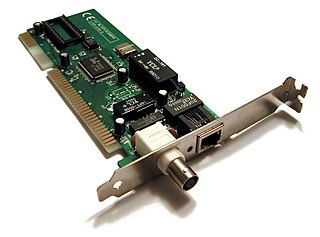
A network interface controller is a computer hardware component that connects a computer to a computer network.

In computer hardware, a host controller, host adapter, or host bus adapter (HBA), connects a computer, which acts as the host system, to other network and storage devices. The terms are primarily used to refer to devices for connecting SCSI, Fibre Channel and SATA devices. Devices for connecting to IDE, Ethernet, FireWire, USB and other systems may also be called host adapters.
TCP offload engine (TOE) is a technology used in network interface cards (NIC) to offload processing of the entire TCP/IP stack to the network controller. It is primarily used with high-speed network interfaces, such as gigabit Ethernet and 10 Gigabit Ethernet, where processing overhead of the network stack becomes significant.
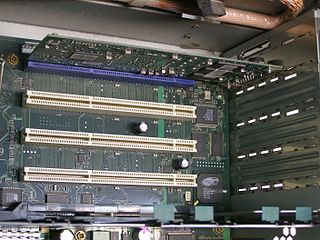
PCI-X, short for Peripheral Component Interconnect eXtended, is a computer bus and expansion card standard that enhances the 32-bit PCI local bus for higher bandwidth demanded mostly by servers and workstations. It uses a modified protocol to support higher clock speeds, but is otherwise similar in electrical implementation. PCI-X 2.0 added speeds up to 533 MHz, with a reduction in electrical signal levels.
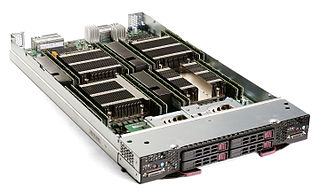
A blade server is a stripped-down server computer with a modular design optimized to minimize the use of physical space and energy. Blade servers have many components removed to save space, minimize power consumption and other considerations, while still having all the functional components to be considered a computer. Unlike a rack-mount server, a blade server fits inside a blade enclosure, which can hold multiple blade servers, providing services such as power, cooling, networking, various interconnects and management. Together, blades and the blade enclosure form a blade system, which may itself be rack-mounted. Different blade providers have differing principles regarding what to include in the blade itself, and in the blade system as a whole.
Brocade is an American technology company specializing in storage networking products, now a subsidiary of Broadcom Inc. The company is known for its Fibre Channel storage networking products and technology. Prior to the acquisition, the company expanded into adjacent markets including a wide range of IP/Ethernet hardware and software products. Offerings included routers and network switches for data center, campus and carrier environments, IP storage network fabrics; Network Functions Virtualization (NFV) and software-defined networking (SDN) markets such as a commercial edition of the OpenDaylight Project controller; and network management software that spans physical and virtual devices.
Emulex Corporation provides network connectivity, monitoring and management hardware and software. The company's I/O connectivity offerings, including its line of Ethernet and Fibre Channel-based connectivity products, were used in server and storage products from OEMs, including Cisco, Dell, EMC Corporation, Fujitsu, Hitachi, HP, Huawei, IBM, NetApp, and Oracle Corporation.

QLogic Corporation was an American manufacturer of networking server and storage networking connectivity and application acceleration products, based in Aliso Viejo, California through 2016. QLogic's products include Fibre Channel adapters, converged network adapters for Fibre Channel over Ethernet (FCoE), Ethernet network interface controllers, iSCSI adapters, and application-specific integrated circuits (ASICs). It was a public company from 1992 to 2016.
The current portfolio of PowerConnect switches are now being offered as part of the Dell Networking brand: information on this page is an overview of all current and past PowerConnect switches as per August 2013, but any updates on current portfolio will be detailed on the Dell Networking page.
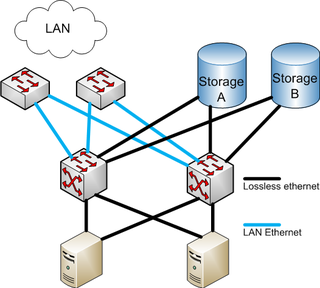
Fibre Channel over Ethernet (FCoE) is a computer network technology that encapsulates Fibre Channel frames over Ethernet networks. This allows Fibre Channel to use 10 Gigabit Ethernet networks while preserving the Fibre Channel protocol. The specification was part of the International Committee for Information Technology Standards T11 FC-BB-5 standard published in 2009.
The Cisco Nexus series switches are modular and fixed port network switches designed for the data center. Cisco Systems introduced the Nexus Series of switches on January 28, 2008. The first chassis in the Nexus 7000 family is a 10-slot chassis with two supervisor engine slots and eight I/O module slots at the front, as well as five crossbar switch fabric modules at the rear. Beside the Nexus 7000 there are also other models in the Nexus range.
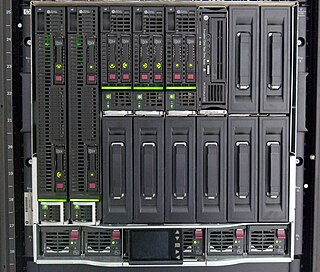
BladeSystem is a line of blade server machines from Hewlett Packard Enterprise that was introduced in June 2006.
Data center bridging (DCB) is a set of enhancements to the Ethernet local area network communication protocol for use in data center environments, in particular for use with clustering and storage area networks.

The Dell blade server products are built around their M1000e enclosure that can hold their server blades, an embedded EqualLogic iSCSI storage area network and I/O modules including Ethernet, Fibre Channel and InfiniBand switches.

SCST is a GPL licensed SCSI target software stack. The design goals of this software stack are high performance, high reliability, strict conformance to existing SCSI standards, being easy to extend and easy to use. SCST does not only support multiple SCSI protocols but also supports multiple local storage interfaces and also storage drivers implemented in user-space via the scst_user driver.
Dell Networking is the new name for the networking portfolio of Dell. In the first half of 2013, Dell started to re-brand their different existing networking product brands to Dell Networking. Dell Networking will be the new name for the networking-equipment that was known as Dell PowerConnect as well as the Force10 portfolio.
Gen 5 Fibre Channel is the marketing name for purpose-built, data center network infrastructure for storage that provides reliability, scalability and up to 16 Gbit/s performance adopted by Brocade, Emulex, and QLogic. The name was created to move away from speed-based naming to technology generation-based naming. Gen 5 Fibre Channel is based on the 5th generation of.
Enterprise Storage OS, also known as ESOS, is a Linux distribution that serves as a block-level storage server in a storage area network (SAN). ESOS is composed of open-source software projects that are required for a Linux distribution and several proprietary build and install time options. The SCST project is the core component of ESOS; it provides the back-end storage functionality.










